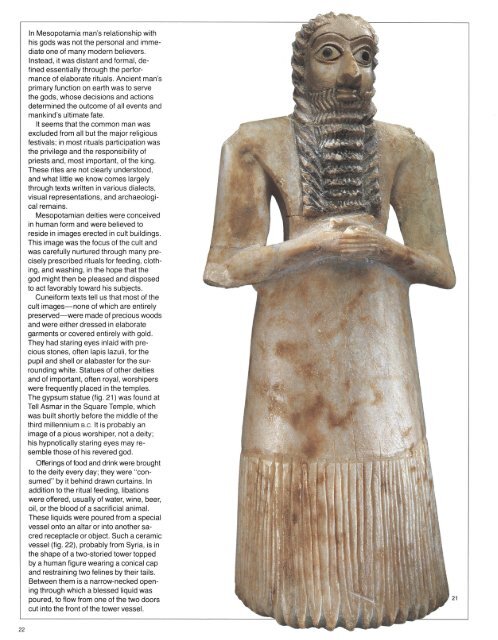Ancient Near Eastern Art: The Metropolitan Museum of Art Bulletin, v ...
Ancient Near Eastern Art: The Metropolitan Museum of Art Bulletin, v ...
Ancient Near Eastern Art: The Metropolitan Museum of Art Bulletin, v ...
Create successful ePaper yourself
Turn your PDF publications into a flip-book with our unique Google optimized e-Paper software.
his gods was not personal<br />
diate one <strong>of</strong> many modern believers.<br />
Instead, it was distant and formal, defined<br />
essentially through the performance<br />
<strong>of</strong> elaborate rituals. <strong>Ancient</strong> man's<br />
primary function on earth was to serve<br />
the gods, whose decisions and actions<br />
determined the outcome <strong>of</strong> all events and<br />
mankind's ultimate fate.<br />
It seems that the common man was<br />
excluded from all but the major religious<br />
festivals; in most rituals participation was<br />
the privilege and the responsibility <strong>of</strong><br />
priests and, most important, <strong>of</strong> the king.<br />
<strong>The</strong>se rites are not clearly understood,<br />
and what little we know comes largely<br />
through texts written in various dialects,<br />
visual representations, and archaeological<br />
remains.<br />
Mesopotamian deities were conceived<br />
in human form and were believed to<br />
reside in images erected in cult buildings.<br />
This image was the focus <strong>of</strong> the cult and<br />
was carefully nurtured through many precisely<br />
prescribed rituals for feeding, clothing,<br />
and washing, in the hope that the<br />
god might then be pleased and disposed<br />
to act favorably toward his subjects.<br />
Cuneiform texts tell us that most <strong>of</strong> the<br />
cult images-none <strong>of</strong> which are entirely<br />
preserved-were made <strong>of</strong> precious woods<br />
and were either dressed in elaborate<br />
garments or covered entirely with gold.<br />
<strong>The</strong>y had staring eyes inlaid with precious<br />
stones, <strong>of</strong>ten lapis lazuli, for the<br />
pupil and shell or alabaster for the surrounding<br />
white. Statues <strong>of</strong> other deities<br />
and <strong>of</strong> important, <strong>of</strong>ten royal, worshipers<br />
were frequently placed in the temples.<br />
<strong>The</strong> gypsum statue (fig. 21) was found at<br />
Tell Asmar in the Square Temple, which<br />
was built shortly before the middle <strong>of</strong> the<br />
third millennium B.C. It is probably an<br />
image <strong>of</strong> a pious worshiper, not a deity;<br />
his hypnotically staring eyes may resemble<br />
those <strong>of</strong> his revered god.<br />
Offerings <strong>of</strong> food and drink were brought<br />
to the deity every day; they were "consumed"<br />
by it behind drawn curtains. In<br />
addition to the ritual feeding, libations<br />
were <strong>of</strong>fered, usually <strong>of</strong> water, wine, beer,<br />
oil, or the blood <strong>of</strong> a sacrificial animal.<br />
<strong>The</strong>se liquids were poured from a special<br />
vessel onto an altar or into another sacred<br />
receptacle or object. Such a ceramic<br />
vessel (fig. 22), probably from Syria, is in<br />
the shape <strong>of</strong> a two-storied tower topped<br />
by a human figure wearing a conical cap<br />
and restraining two felines by their tails.<br />
Between them is a narrow-necked opening<br />
through which a blessed liquid was<br />
poured, to flow from one <strong>of</strong> the two doors<br />
cut into the front <strong>of</strong> the tower vessel.<br />
22

















